In Spain, there’s a phrase, “convidado de piedra”, which refers to an invited guest who remains mute or unnoticed. In other words, a wallflower. Convidado de piedra pretty much sums up olive oil at the Spanish dining table – it’s around but not exactly popular (“Is she a virgin?” “I heard she’s an extra virgin”), everyone engages once but takes it for granted, and at the end of the night, it’s practically forgotten.
Whereas its more popular, sexy and complex Spanish counterpart – wine – is “la alma de la fiesta”, the life and “soul of the party”, the attractive one that stays on for hours until it’s spent, a signal for everyone to call it a night and head home.
Thing is, I happen to like the unpopular, quiet types, because if life has ever taught me anything, it’s usually the shy ones that have the most meaningful thoughts in their heads. And so there I was at the Escuela Europea de Cata de Aceite y Oleocultura (The European School of Olive Oil) to find out just exactly what this unassuming one was all about, in a special class and olive oil tasting session.
Even mentioning to some friends that I was attending an olive oil tasting – and not the more prominent cata de vino (wine tasting) – was like admitting that I was making an appearance at the class nerd’s birthday party. ¡Sin alcohol! What fresh hell is this??!
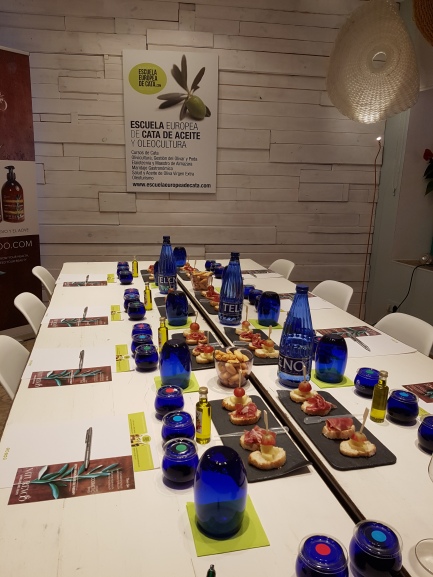
A Brief History of the Olive
But as I soon found out, there is a lot more to olive oil than people care to think about or even stop to reflect on. For one, it’s the cornerstone of the Mediterranean diet, which has been listed as a UNESCO Intangible Cultural Heritage of Humanity. The olive itself has been a symbol of wealth and peace with a history tracing back 6,000 years in the Levant, the Middle East and Europe, and has played a central role in culture, art and trade in these regions.
And of course, olive oil is the basic staple of daily life in Spain.
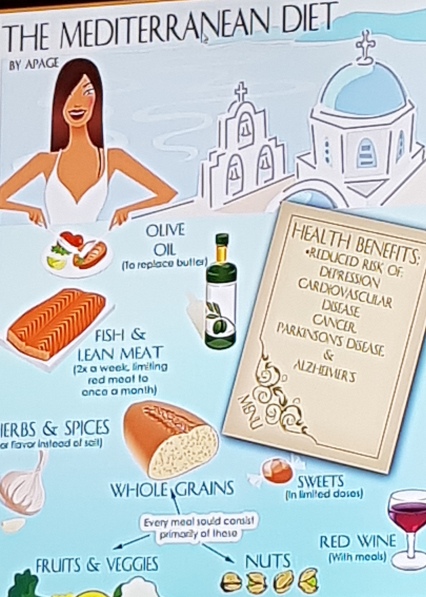
“Olive oil is the ultimate superfood,” shared Mar, our host, lecturer and olive oil sage for the night. ” Extra virgin olive oil especially contains tyrosol phenolic compounds such as oleuropein and oleocanthal – which account for its bitter and pungent taste.
(If you’re still with me, I also learned that Oleocanthal, oleurpein and hydroxytyrosol are nature’s most powerful antioxidants.)
Taste the Mediterranean
Now for the fun part – the olive oil tasting session!
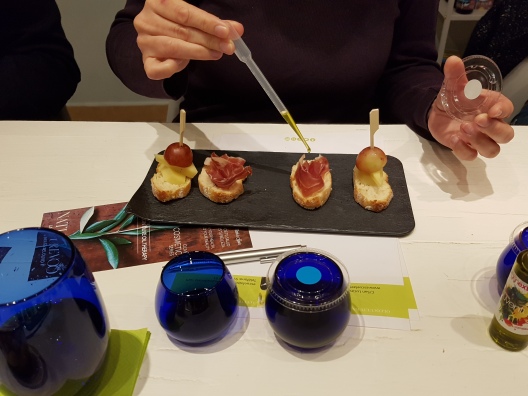
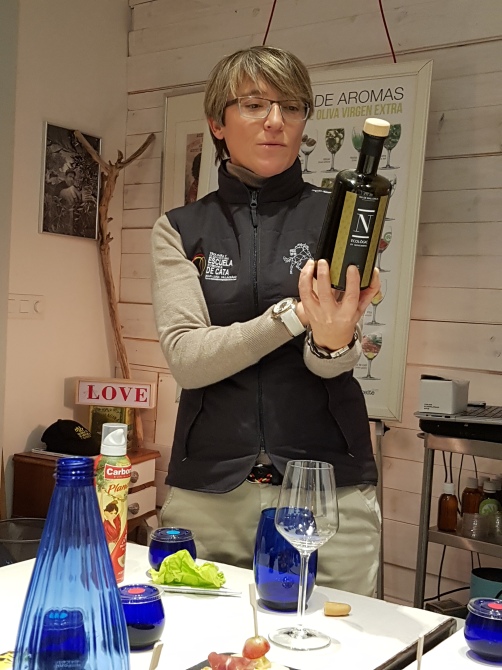
Three types of olive oil were placed inside covered, round blue glasses. We were told to warm the oil first by cupping the glass, and thereafter removed the covers to breathe in its aroma. A collective sigh from the class ensued, with “oohs and ahhs” all around. And then we took a little sip…
“It reminds me of mushrooms in Nepal!”
“It smells like the countryside in Syria…”
“It takes me back to the early mornings in Cadaqués, having breakfast with pan con tomate while reflecting on the life of Salvador Dalí and Marcel Duchamp…” (That’s actually what I thought, pretentious shmuck that I am, but thankfully I never said it out loud.)
Ummm…vale, said Mar with a smirk. That’s because what we had actually tasted and praised to high heavens was “lampante” – as in the oil burned in oil lamps, or the poorest quality olive oil made from overripe black olives and refined in factories for mass production.
*Sheepish looks all around*
But right before we started to dig holes in the ground to bury our heads in, Mar assured us that it was perfectly understandable, because we’re just long used to the commercial olive oil – you know, the 3 euro bottle on the supermarket shelf that we don’t think twice about grabbing.
And then we moved on to tasting the second and third cups – and what a world of difference they were. For one, a little sip of it turned out to be fruity, bitter and…spicy! Could this be?? I could discern the levels of taste and textures in my mouth and throat as seconds passed. We had levelled up to Virgin Olive Oil.
The biggest revelation for the night of course was the Extra Virgin Olive Oil (“EVOO”). Mar unveiled its true color in a clear glass, and it was notably a pine green color – very different from the yellow shade of the processed, commercial olive oil in a typical Spanish household.
“‘EVOO’ is what we should all be spending a little bit more on,” said Mar, to invest in our health as it is produced from ripe, green olives and has zero chemicals. “Consuming this every day helps prevent cancer,” she added.
But extra virgin olive oil is just so much more expensive than the others, someone commented. True, but if you think about it, buying a 10eu bottle is less than what you’d pay for for a caña and gin tonic on a night out. Touché.
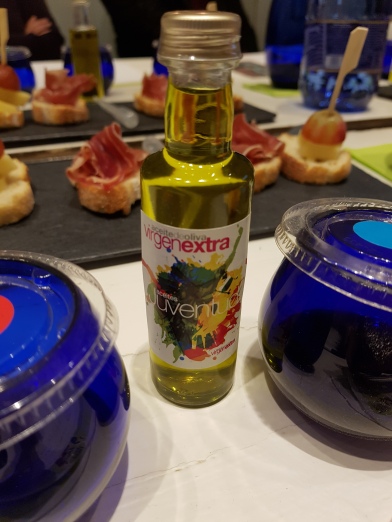
To compare tastes, we added droplets of the three types of oil on the tapas set of jamón, cheese and fruits before us. The verdict? WOW, indeed, there is an entire other world of difference in taste. I have seen the light (and it’s only 10 eu more than usual at the supermarket!).
As the night wound down, our happy and satisfied class savoured the elevated, extra virginized jamón and already felt like more knowledgeable food nerds.
My suspicions had been confirmed, there is so much more behind the quiet, reserved ones at the table, you need only to take time to get to know them better.
Now, to end our perfect night with a glass of rioja…
****
Special thanks, muchísimas gracias to the Escuela Europea de Cata de Aceite y Oleocultura and Expat Gourmet Club for the experience.
Thanks for this interesting post. We visited a plantation a few years ago, and the process was very interesting and followed by a tasting. Surprising at first and it made me aware of the wide variety of olive oils.
Does the school you went to offer tasting to visitors? I’m going for a few days to Madrid and would love experiencing it! Thanks!
LikeLike
Hello, and thank you for commenting! Yes, the school definitely offers tasting for visitors, I’m just unsure whether they do it in English (the slide presentation was in English tho, so better check). The school is also located in a fun area, Barrio Chueca, where you can go for tapas after. Here is their website: http://www.escuelaeuropeadecata.com/ 🙂
LikeLiked by 1 person
Great! Thanks a lot. And thanks for the follow 🙂
LikeLiked by 1 person